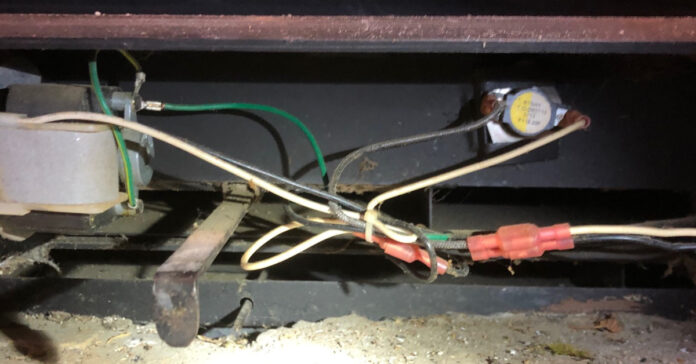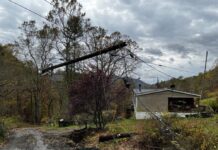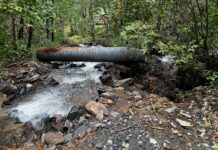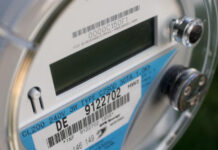Looks like we’ll be waking up to more snow on Sunday, possibly another six inches or so. Good thing we went to town when we did!
As I have mentioned before, we have a big wood stove in the basement and a smaller fireplace insert upstairs.
The fireplace insert is a Buck Stove model 74 and uses a blower to blow warm air into the house. I have disliked this approach because it requires electricity to function and without electricity, the insert produces almost no heat at all. Adding to the complexity, the stove uses a thermostat to turn on and off the blower. Apparently, it won’t go on until the temperature reaches 140 degrees.
Lately, my wife has been complaining that it’s taking longer and longer for the blower to kick on. I’ve been thinking that maybe the fire is not hot enough, until yesterday when the blower did not go on at all. I check it out, and the fire is merrily burning away, yet the blower is off and hardly any heat is entering the house. Talk about a waste of firewood!
Now as an aside, the insert is reported to heat up to a 2,600 square foot house, to which I say, no way. If you put a Model 74 stove (not an insert) in the middle of 60×40 or 50×50 room and let head radiate out in all directions, then I can see how that it would probably effectively heat the space. But you encase the same stove in your masonry fireplace (which is what a fireplace insert is) and add with a little blower motor to push warm air out, it fails miserably. Our upstairs is far less than 2,400 square feet and the insert is insufficient to keep the temperature anywhere near normal all by itself.
Efficiency vs Heat Production
While this insert may burn wood more efficiently than our old basement stove, it generates nowhere near the same amount of heat. When it’s cold out and you are heating with wood, I find that heat production is more important than burning efficiency. I will take a stove with a large fire box that is 10 percent less efficient if it means the room is 10 degrees warmer. I don’t care if it takes more firewood; its worth it to me.
In general, the wood stove in the basement raises the temperature upstairs faster than using the fireplace insert alone. We tend to rely on the basement stove as our primary heat source and turn on the blower when we just want to boost the heat upstairs or when it is well below freezing for an extended period of time and the cold start seeping through the thick wood walls.
Diagnosing the Problem
So, how do we fix the blower? I remove the front panel of the insert and the wiring is pretty basic. By that, I mean no visible circuit boards. The stove is plugged in. I check the outlet and it has electricity, so that is not the problem.
From there, the power appears to flow this order:
- To a thermostat that turns on the blower when the temperature around the insert is above 140.
- From there, it goes to a rheostat that we use to manually adjust the speed of the blower. This also functions as an on/off switch.
- Then the power flows to what appears to be a transformer that changes the 120 volt power to something the blower can use. Maybe it’s DC, maybe not. I didn’t bother to check.
- To the blower.
Any one of these could be broken. My hope is that it is not the blower because that is the most expensive part. I highly doubt it is the transformer; those things are old technology and well understood. There are also no moving parts or wear points. That leaves the rheostat or the thermostat. I test the thermostat by using a short piece of wire to jump the two points on either side of it, and the blower functions. Hooray! Problem identified. We have a bad thermostat.
Solve the Problem
Apparently this is not an unusual point of failure because online sites are filled with replacement thermostats for anywhere from $15 to $50. (Yes, it pays to shop around.) Since this item has failed partway into our first winter of use, I decide that I should get two so we have a back-up.
Buying this part on a weekend and waiting for it to be delivered (slowly) to our post office box is not really ideal because we can’t use the stove until then. For the short term, I dig into my electric parts box and cobble together jumper. By unplugging the thermostat and plugging the wires into the juper, I can bypass the thermostat and the blower runs. We just have to turn it on and off manually.

Buying this part on a weekend and waiting for it to be delivered (slowly) to our post office box is not really ideal because we can’t use the stove until then. For the short term, I dig into my electric parts box and cobble together jumper. By unplugging the thermostat and plugging the wires into the juper, I can bypass the thermostat and the blower runs. We just have to turn it on and off manually.
The problem with this solution is that if the fire dies down, the blower keeps blowing. That’s an inconvenience because we often go to bed with the blower humming along, pushing warm air into the room and then wake up hours later with the fire died down, the blower has been turned off automatically. But we can live with for a week or so. I’ll just turn the blower off when I go to bed.








